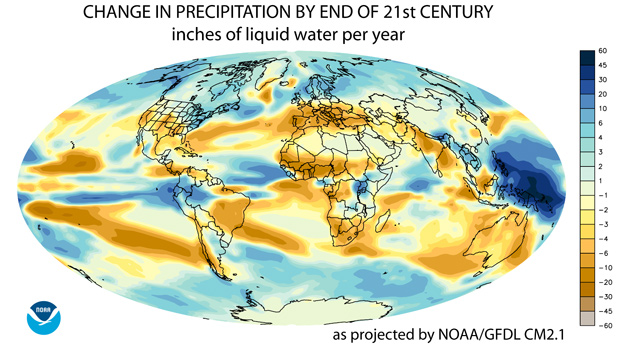Climate Change Predictions
As we have seen, climate change will alter precipitation patterns on a global scale, leading to higher rainfall in some areas and significantly lower rainfall in others.
Superimposed on this will be changes in evaporation, runoff, and soil moisture, which will generally exacerbate droughts in areas where rainfall decreases. Generally speaking, regions that are already dry will not get wetter in the next century, and many will become significantly drier.

Regions that are already wet will often become much wetter in the future. Climate change will act in tandem with stressors on the water sector as a result of population increase. Therefore, climate change will generally render precipitation patterns more unequal than they are today. Further, as stated by the Intergovernmental Panel on Climate Change (IPCC),
The negative impacts of climate change on water resources….will outweigh the positive impacts in all regions of the world. Those places in which precipitation and runoff are projected to decline are likely to derive less overall benefit from freshwater resources. In those places that receive more annual runoff, the benefits of increased water flows are expected to be offset by the adverse effects that greater precipitation variability and changes in seasonal runoff have on water supply, water quality, and risk of flooding. (Intergovernmental Panel on Climate Change)
In more detail, recently observed trends of decreasing precipitation over latitudes 30°N to 10°S are projected to continue. Thus, arid and semi-arid regions in the south-central US, Southern Africa, and the Mediterranean are expected to experience decreasing water supply. In some of these regions, water availability is projected to decrease 10-30% by 2050. The IPCC estimates that two-thirds of the world population could be living underwater stress or water scarcity by 2025.
The areas that are expected to suffer some of the worst consequences of changing precipitation are generally some of the least developed and poorest nations, with some of the highest rates of population growth. This combination will likely lead to significantly reduced groundwater recharge, declining surface water reservoir levels, increase in the frequency of groundwater pollution, and most critically, to rapid declines in per capita water availability.
Increased precipitation intensity, more extreme events, increased runoff, decreased infiltration, increased likelihood of contamination with sewage, fertilizers and farm wastes, less ice and snow storage, and increased droughts even in areas that receive more precipitation all will place burdens on water supplies in the future.
